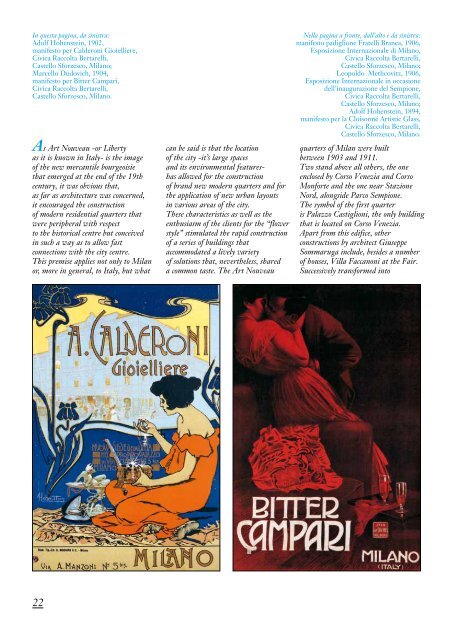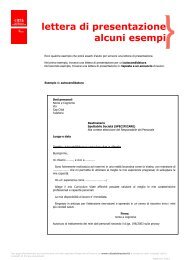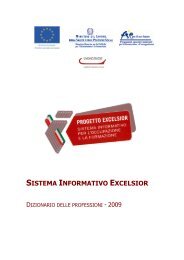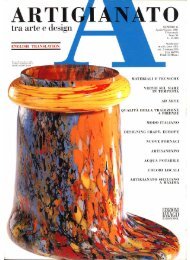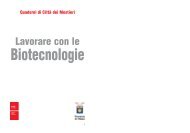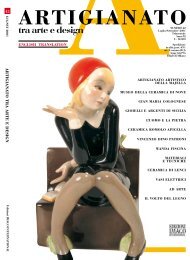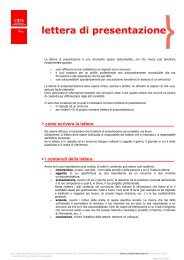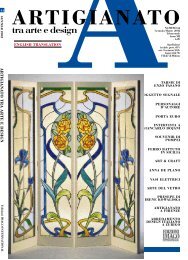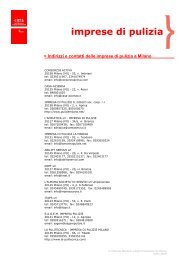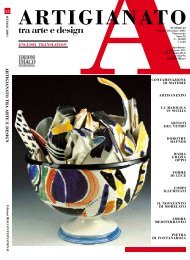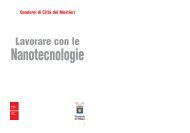Numero 52 - Città dei Mestieri
Numero 52 - Città dei Mestieri
Numero 52 - Città dei Mestieri
You also want an ePaper? Increase the reach of your titles
YUMPU automatically turns print PDFs into web optimized ePapers that Google loves.
In questa pagina, da sinistra:<br />
Adolf Hohenstein, 1902,<br />
manifesto per Calderoni Gioielliere,<br />
Civica Raccolta Bertarelli,<br />
Castello Sforzesco, Milano;<br />
Marcello Dudovich, 1904,<br />
manifesto per Bitter Campari,<br />
Civica Raccolta Bertarelli,<br />
Castello Sforzesco, Milano.<br />
As Art nouveau -or Liberty<br />
as it is known in Italy- is the image<br />
of the new mercantile bourgeoisie<br />
that emerged at the end of the 19th<br />
century, it was obvious that,<br />
as far as architecture was concerned,<br />
it encouraged the construction<br />
of modern residential quarters that<br />
were peripheral with respect<br />
to the historical centre but conceived<br />
in such a way as to allow fast<br />
connections with the city centre.<br />
This premise applies not only to Milan<br />
or, more in general, to Italy, but what<br />
22<br />
can be said is that the location<br />
of the city -it’s large spaces<br />
and its environmental features-<br />
has allowed for the construction<br />
of brand new modern quarters and for<br />
the application of new urban layouts<br />
in various areas of the city.<br />
These characteristics as well as the<br />
enthusiasm of the clients for the “flower<br />
style” stimulated the rapid construction<br />
of a series of buildings that<br />
accommodated a lively variety<br />
of solutions that, nevertheless, shared<br />
a common taste. The Art nouveau<br />
nella pagina a fronte, dall’alto e da sinistra:<br />
manifesto padiglione Fratelli Branca, 1906,<br />
Esposizione Internazionale di Milano,<br />
Civica Raccolta Bertarelli,<br />
Castello Sforzesco, Milano;<br />
Leopoldo Metlicovitz, 1906,<br />
Esposizione Internazionale in occasione<br />
dell’inaugurazione del Sempione,<br />
Civica Raccolta Bertarelli,<br />
Castello Sforzesco, Milano;<br />
Adolf Hohenstein, 1894,<br />
manifesto per la Cloisonné Artistic Glass,<br />
Civica Raccolta Bertarelli,<br />
Castello Sforzesco, Milano.<br />
quarters of Milan were built<br />
between 1903 and 1911.<br />
Two stand above all others, the one<br />
enclosed by Corso Venezia and Corso<br />
Monforte and the one near Stazione<br />
nord, alongside Parco Sempione.<br />
The symbol of the first quarter<br />
is Palazzo Castiglioni, the only building<br />
that is located on Corso Venezia.<br />
Apart from this edifice, other<br />
constructions by architect Giuseppe<br />
Sommaruga include, besides a number<br />
of houses, Villa Faccanoni at the Fair.<br />
Successively transformed into


